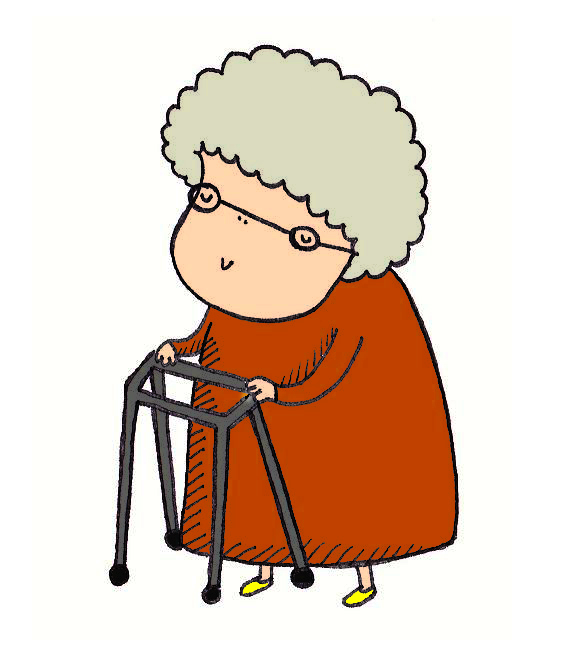Have you ever seen an old lady on a walker gracefully navigating her way through life? It's not just about mobility—it's a testament to strength, determination, and the unyielding spirit of aging gracefully. In this article, we'll dive deep into the world of walkers, their importance, and how they empower seniors to live life on their terms.
Picture this: a sunny afternoon, and you spot an elderly woman gliding smoothly with her walker. She’s not just moving from one point to another; she’s reclaiming her independence. The image of an old lady on a walker symbolizes more than just physical support—it’s a story of resilience, adaptability, and embracing life despite challenges. And that's what we're here to explore today.
So, why does this topic matter so much? Because it’s not just about the device itself. It’s about understanding the journey of seniors who rely on walkers, the emotional and physical challenges they face, and how these tools can transform their lives. Whether you’re a caregiver, a family member, or simply someone curious about aging, this article has something for everyone.
Read also:Crazy Jnco Rep The Lowdown On The Iconic Wideleg Jeans That Defined A Generation
Understanding the Role of Walkers in Senior Mobility
Let’s get real for a second—walkers aren’t just pieces of equipment. They’re lifelines for many older adults, especially those dealing with mobility issues. For an old lady on a walker, this tool isn’t just about getting from the living room to the kitchen. It’s about maintaining dignity and independence in everyday life.
Studies show that over 1.4 million Americans use walkers daily, and that number is only growing as the population ages. Walkers come in various forms—standard, rolling, folding, and even those with built-in seats. Each type caters to specific needs, ensuring seniors can move confidently and safely.
Types of Walkers: Finding the Perfect Fit
Not all walkers are created equal, and choosing the right one is crucial. Here’s a quick rundown of the most common types:
- Standard Walkers: These are the classic ones without wheels, ideal for those needing maximum stability.
- Rolling Walkers: Equipped with wheels, these are great for people who need less support but want to move faster.
- Folding Walkers: Perfect for travel or storage, these can be easily collapsed and carried.
- Walker with Seats: A game-changer for those who need a place to rest during long walks.
Choosing the right walker depends on factors like physical condition, lifestyle, and personal preferences. It’s not a one-size-fits-all solution, and that’s why consulting a healthcare professional is always a good idea.
Physical and Emotional Benefits of Using a Walker
Now, let’s talk about the good stuff—the benefits. For an old lady on a walker, the advantages go beyond just staying upright. Walkers improve balance, reduce the risk of falls, and enhance overall mobility. But that’s not all—they also boost mental health and self-esteem.
According to the National Institute on Aging, regular use of mobility aids like walkers can significantly reduce the fear of falling, which is a common concern among seniors. This newfound confidence encourages them to engage in more activities, stay socially connected, and enjoy a better quality of life.
Read also:Can I Use Glycolic Acid After Panoxyl The Ultimate Guide For Clear Skin
Breaking the Stigma: Walkers as Symbols of Strength
There’s a common misconception that using a walker means giving up independence. On the contrary, it’s quite the opposite. Walkers empower seniors to take charge of their lives, proving that age is just a number. An old lady on a walker isn’t someone to pity—she’s someone to admire for her courage and perseverance.
Embracing a walker isn’t about accepting limitations; it’s about creating opportunities. It’s about saying, “Yes, I can do this!” and proving to the world—and yourself—that mobility doesn’t have to decline with age.
Choosing the Right Walker: Tips and Considerations
So, you’ve decided to get a walker for yourself or a loved one. Great choice! But where do you start? Here are some tips to help you find the perfect fit:
- Measure the height and weight of the user to ensure proper sizing.
- Consider the terrain where the walker will be used—indoors, outdoors, or both.
- Look for features like adjustable heights, lightweight materials, and easy-to-use brakes.
- Think about additional accessories, such as baskets or cup holders, for convenience.
Remember, the right walker should feel comfortable and secure. Don’t hesitate to try different models before making a decision. After all, it’s an investment in mobility and independence.
Common Mistakes to Avoid When Selecting a Walker
While choosing a walker might seem straightforward, there are a few pitfalls to watch out for:
- Buying a walker that’s too heavy or difficult to maneuver.
- Ignoring the importance of proper fit and adjustment.
- Not considering the user’s specific needs and preferences.
Avoid these mistakes, and you’ll be well on your way to finding the perfect walker for your needs.
Maintaining a Walker: A Guide to Longevity
Once you’ve got your walker, it’s important to keep it in top condition. Regular maintenance ensures it remains safe and effective for years to come. Here’s how:
- Check the wheels and brakes regularly for wear and tear.
- Clean the frame and moving parts to prevent rust and dirt buildup.
- Inspect the rubber tips or glides for signs of damage or flattening.
Taking care of your walker is like taking care of any other important tool—it’s all about routine and attention to detail. Plus, a well-maintained walker lasts longer, saving you money in the long run.
DIY Walker Repairs: Can You Do It Yourself?
While some repairs are best left to professionals, there are a few simple fixes you can tackle yourself:
- Replacing worn-out rubber tips or glides.
- Tightening loose screws or bolts.
- Adjusting the height for a better fit.
But if you’re unsure or uncomfortable with DIY repairs, don’t hesitate to seek help from a professional. Safety should always come first.
Encouraging Independence: Tips for Caregivers
For caregivers, supporting an old lady on a walker can be both rewarding and challenging. Here’s how you can make the experience smoother:
- Encourage regular practice and confidence-building exercises.
- Ensure the environment is safe and free from obstacles.
- Provide emotional support and reassurance when needed.
Remember, your role as a caregiver is to empower, not enable. Encourage independence while being there to lend a helping hand when necessary.
Building a Supportive Environment for Walker Users
A supportive environment makes all the difference for someone using a walker. Here are some ideas:
- Install grab bars and handrails in key areas like bathrooms and hallways.
- Clear pathways and remove tripping hazards like rugs or clutter.
- Create designated spaces for resting or storing the walker when not in use.
Small changes can have a big impact on safety and convenience. A well-designed space encourages mobility and reduces the risk of accidents.
Success Stories: Real-Life Examples of Walker Users
Let’s hear from some real people who’ve made walkers a part of their daily lives. Here’s a story from Mary, a 78-year-old who rediscovered her love for walking:
“When I first got my walker, I was scared it would make me look weak. But now, I realize it’s the opposite. I can walk farther, faster, and with more confidence than ever before. It’s opened up a whole new world for me!”
Stories like Mary’s remind us that walkers aren’t just tools—they’re life-changing solutions for many seniors.
Testimonials from Caregivers and Families
Caregivers and families also have plenty to say about the benefits of walkers:
“Seeing my mom use her walker with such confidence brings me so much joy. It’s like she’s regained a piece of herself she thought she’d lost.”
These testimonials highlight the positive impact walkers can have on both users and their loved ones.
Conclusion: Embrace the Journey
In conclusion, the image of an old lady on a walker is more than just a snapshot—it’s a symbol of resilience, independence, and the power of adaptability. Walkers aren’t just tools; they’re lifelines that enable seniors to live life on their terms.
We’ve explored the types of walkers, their benefits, how to choose the right one, and tips for maintaining them. We’ve also heard inspiring stories from real users and caregivers, proving that walkers truly make a difference.
So, what’s next? If you or a loved one is considering a walker, don’t hesitate to take the first step. And if you’ve found this article helpful, share it with others who might benefit. Together, let’s celebrate the journey of aging gracefully and staying mobile.
Table of Contents
- Understanding the Role of Walkers in Senior Mobility
- Types of Walkers: Finding the Perfect Fit
- Physical and Emotional Benefits of Using a Walker
- Breaking the Stigma: Walkers as Symbols of Strength
- Choosing the Right Walker: Tips and Considerations
- Common Mistakes to Avoid When Selecting a Walker
- Maintaining a Walker: A Guide to Longevity
- DIY Walker Repairs: Can You Do It Yourself?
- Encouraging Independence: Tips for Caregivers
- Building a Supportive Environment for Walker Users
- Success Stories: Real-Life Examples of Walker Users
- Testimonials from Caregivers and Families


